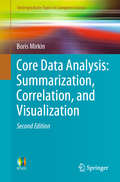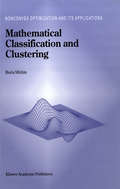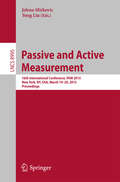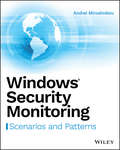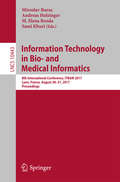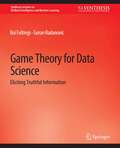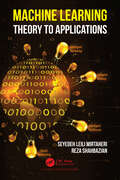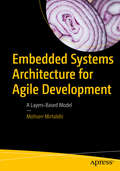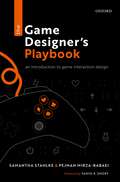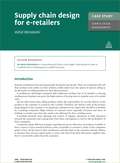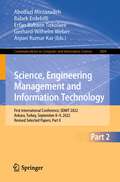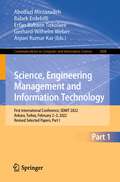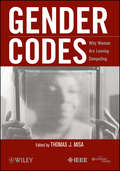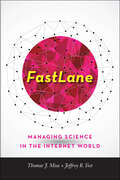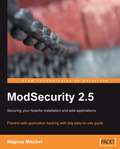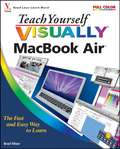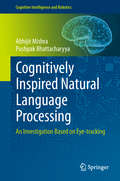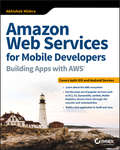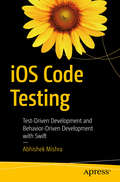- Table View
- List View
Core Data Analysis: Summarization, Correlation And Visualization (Undergraduate Topics in Computer Science)
by Boris MirkinThis text examines the goals of data analysis with respect to enhancing knowledge, and identifies data summarization and correlation analysis as the core issues. Data summarization, both quantitative and categorical, is treated within the encoder-decoder paradigm bringing forward a number of mathematically supported insights into the methods and relations between them. Two Chapters describe methods for categorical summarization: partitioning, divisive clustering and separate cluster finding and another explain the methods for quantitative summarization, Principal Component Analysis and PageRank. Features:· An in-depth presentation of K-means partitioning including a corresponding Pythagorean decomposition of the data scatter. · Advice regarding such issues as clustering of categorical and mixed scale data, similarity and network data, interpretation aids, anomalous clusters, the number of clusters, etc.· Thorough attention to data-driven modelling including a number of mathematically stated relations between statistical and geometrical concepts including those between goodness-of-fit criteria for decision trees and data standardization, similarity and consensus clustering, modularity clustering and uniform partitioning.New edition highlights: · Inclusion of ranking issues such as Google PageRank, linear stratification and tied rankings median, consensus clustering, semi-average clustering, one-cluster clustering· Restructured to make the logics more straightforward and sections self-containedCore Data Analysis: Summarization, Correlation and Visualization is aimed at those who are eager to participate in developing the field as well as appealing to novices and practitioners.
Mathematical Classification and Clustering (Nonconvex Optimization and Its Applications #11)
by Boris MirkinI am very happy to have this opportunity to present the work of Boris Mirkin, a distinguished Russian scholar in the areas of data analysis and decision making methodologies. The monograph is devoted entirely to clustering, a discipline dispersed through many theoretical and application areas, from mathematical statistics and combina torial optimization to biology, sociology and organizational structures. It compiles an immense amount of research done to date, including many original Russian de velopments never presented to the international community before (for instance, cluster-by-cluster versions of the K-Means method in Chapter 4 or uniform par titioning in Chapter 5). The author's approach, approximation clustering, allows him both to systematize a great part of the discipline and to develop many in novative methods in the framework of optimization problems. The optimization methods considered are proved to be meaningful in the contexts of data analysis and clustering. The material presented in this book is quite interesting and stimulating in paradigms, clustering and optimization. On the other hand, it has a substantial application appeal. The book will be useful both to specialists and students in the fields of data analysis and clustering as well as in biology, psychology, economics, marketing research, artificial intelligence, and other scientific disciplines. Panos Pardalos, Series Editor.
Passive and Active Measurement: 16th International Conference, PAM 2015, New York, NY, USA, March 19-20, 2015, Proceedings (Lecture Notes in Computer Science #8995)
by Jelena Mirkovic Yong LiuThis book constitutes the refereed proceedings of the 16th International Conference on Passive and Active Measurement, PAM 2015, held in New York, NY, USA, in March 2015. The 27 full papers presented were carefully reviewed and selected from 100 submissions. The papers have been organized in the following topical sections: DNS and Routing, Mobile and Cellular, IPv6, Internet-Wide, Web and Peer-to-Peer, Wireless and Embedded, and Software Defined Networking.
Windows Security Monitoring: Scenarios and Patterns
by Andrei MiroshnikovDig deep into the Windows auditing subsystem to monitor for malicious activities and enhance Windows system security Written by a former Microsoft security program manager, DEFCON "Forensics CTF" village author and organizer, and CISSP, this book digs deep into the Windows security auditing subsystem to help you understand the operating system′s event logging patterns for operations and changes performed within the system. Expert guidance brings you up to speed on Windows auditing, logging, and event systems to help you exploit the full capabilities of these powerful components. Scenario–based instruction provides clear illustration of how these events unfold in the real world. From security monitoring and event patterns to deep technical details about the Windows auditing subsystem and components, this book provides detailed information on security events generated by the operating system for many common operations such as user account authentication, Active Directory object modifications, local security policy changes, and other activities. This book is based on the author′s experience and the results of his research into Microsoft Windows security monitoring and anomaly detection. It presents the most common scenarios people should be aware of to check for any potentially suspicious activity. Learn to: Implement the Security Logging and Monitoring policy Dig into the Windows security auditing subsystem Understand the most common monitoring event patterns related to operations and changes in the Microsoft Windows operating system About the Author Andrei Miroshnikov is a former security program manager with Microsoft. He is an organizer and author for the DEFCON security conference "Forensics CTF" village and has been a speaker at Microsoft′s Bluehat security conference. In addition, Andrei is an author of the "Windows 10 and Windows Server 2016 Security Auditing and Monitoring Reference" and multiple internal Microsoft security training documents. Among his many professional qualifications, he has earned the (ISC)2 CISSP and Microsoft MCSE: Security certifications.
Windows Security Monitoring: Scenarios and Patterns
by Andrei MiroshnikovDig deep into the Windows auditing subsystem to monitor for malicious activities and enhance Windows system security Written by a former Microsoft security program manager, DEFCON "Forensics CTF" village author and organizer, and CISSP, this book digs deep into the Windows security auditing subsystem to help you understand the operating system′s event logging patterns for operations and changes performed within the system. Expert guidance brings you up to speed on Windows auditing, logging, and event systems to help you exploit the full capabilities of these powerful components. Scenario–based instruction provides clear illustration of how these events unfold in the real world. From security monitoring and event patterns to deep technical details about the Windows auditing subsystem and components, this book provides detailed information on security events generated by the operating system for many common operations such as user account authentication, Active Directory object modifications, local security policy changes, and other activities. This book is based on the author′s experience and the results of his research into Microsoft Windows security monitoring and anomaly detection. It presents the most common scenarios people should be aware of to check for any potentially suspicious activity. Learn to: Implement the Security Logging and Monitoring policy Dig into the Windows security auditing subsystem Understand the most common monitoring event patterns related to operations and changes in the Microsoft Windows operating system About the Author Andrei Miroshnikov is a former security program manager with Microsoft. He is an organizer and author for the DEFCON security conference "Forensics CTF" village and has been a speaker at Microsoft′s Bluehat security conference. In addition, Andrei is an author of the "Windows 10 and Windows Server 2016 Security Auditing and Monitoring Reference" and multiple internal Microsoft security training documents. Among his many professional qualifications, he has earned the (ISC)2 CISSP and Microsoft MCSE: Security certifications.
Information Technology in Bio- and Medical Informatics: 8th International Conference, ITBAM 2017, Lyon, France, August 28–31, 2017, Proceedings (Lecture Notes in Computer Science #10443)
by Miroslav Bursa, Andreas Holzinger, M. Elena Renda and Sami KhuriThis book constitutes the refereed proceedings of the 8th International Conference on Information Technology in Bio- and Medical Informatics, ITBAM 2017, held in Lyon, France, in August 2017.The 3 revised full papers and 6 poster papers presented were carefully reviewed and selected from 15 submissions. The papers address a broad range of topics in applications of information technology to biomedical engineering and medical informatics.
Game Theory for Data Science: Eliciting Truthful Information (Synthesis Lectures on Artificial Intelligence and Machine Learning)
by Boi Mirsky Goran KerenIntelligent systems often depend on data provided by information agents, for example, sensor data or crowdsourced human computation. Providing accurate and relevant data requires costly effort that agents may not always be willing to provide. Thus, it becomes important not only to verify the correctness of data, but also to provide incentives so that agents that provide high-quality data are rewarded while those that do not are discouraged by low rewards. We cover different settings and the assumptions they admit, including sensing, human computation, peer grading, reviews, and predictions. We survey different incentive mechanisms, including proper scoring rules, prediction markets and peer prediction, Bayesian Truth Serum, Peer Truth Serum, Correlated Agreement, and the settings where each of them would be suitable. As an alternative, we also consider reputation mechanisms. We complement the game-theoretic analysis with practical examples of applications in prediction platforms, community sensing, and peer grading.
Machine Learning: Theory to Applications
by Seyedeh Leili Mirtaheri Reza ShahbazianThe book reviews core concepts of machine learning (ML) while focusing on modern applications. It is aimed at those who want to advance their understanding of ML by providing technical and practical insights. It does not use complicated mathematics to explain how to benefit from ML algorithms. Unlike the existing literature, this work provides the core concepts with emphasis on fresh ideas and real application scenarios. It starts with the basic concepts of ML and extends the concepts to the different deep learning algorithms. The book provides an introduction and main elements of evaluation tools with Python and walks you through the recent applications of ML in self-driving cars, cognitive decision making, communication networks, security, and signal processing. The concept of generative networks is also presented and focuses on GANs as a tool to improve the performance of existing algorithms. In summary, this book provides a comprehensive technological path from fundamental theories to the categorization of existing algorithms, covers state-of-the-art, practical evaluation tools and methods to empower you to use synthetic data to improve the performance of applications.
Machine Learning: Theory to Applications
by Seyedeh Leili Mirtaheri Reza ShahbazianThe book reviews core concepts of machine learning (ML) while focusing on modern applications. It is aimed at those who want to advance their understanding of ML by providing technical and practical insights. It does not use complicated mathematics to explain how to benefit from ML algorithms. Unlike the existing literature, this work provides the core concepts with emphasis on fresh ideas and real application scenarios. It starts with the basic concepts of ML and extends the concepts to the different deep learning algorithms. The book provides an introduction and main elements of evaluation tools with Python and walks you through the recent applications of ML in self-driving cars, cognitive decision making, communication networks, security, and signal processing. The concept of generative networks is also presented and focuses on GANs as a tool to improve the performance of existing algorithms. In summary, this book provides a comprehensive technological path from fundamental theories to the categorization of existing algorithms, covers state-of-the-art, practical evaluation tools and methods to empower you to use synthetic data to improve the performance of applications.
Embedded Systems Architecture for Agile Development: A Layers-Based Model
by Mohsen MirtalebiUtilize a new layers-based development model for embedded systems using Agile techniques for software architecture and management. Firmware is comprised of both hardware and software, but the applicability of Agile in embedded systems development is new. This book provides a step-by-step process showing how this is possible. The book details how the moving parts in embedded systems development affect one another and shows how to properly use both engineering tools and new tools and methods to reduce waste, rework, and product time-to-market. Software is seen not as a commodity but a conduit to facilitate valuable product knowledge flow across the company into the hands of the customer.Embedded Systems Architecture for Agile Development starts off by reviewing the Layers model used in other engineering disciplines, as well as its advantages and applicability to embedded systems development. It outlines development models from project-based methodologies (e.g., collaborative product development) to the newer modern development visions (e.g., Agile) in software and various tools and methods that can help with a Layers model implementation. The book covers requirement modeling for embedded systems (Hatley-Pirbhai Method) and how adapting the HP Method with the help of the tools discussed in this book can be seen as a practical example for a complete embedded system.What You’ll LearnIdentify the major software parts involved in building a typical modern firmwareAssign a layer to each software part so each layer can be separate from another and there won’t be interdependencies between themSystematically and logically create these layers based on the customer requirementsUse Model-Based Design (MBD) to create an active system architecture that is more accepting of changes Who This Book Is ForFirmware engineers; systems architects; hardware and software managers, developers, designers, and architects; program managers; project managers; Agile practitioners; and manufacturing engineers and managers. The secondary audience includes research engineers and managers, and engineering and manufacturing managers.
The Game Designer's Playbook: An Introduction to Game Interaction Design
by Pejman Mirza-Babaei Samantha StahlkeVideo games have captivated us for over 50 years, giving us entire worlds to explore, new ways to connect with friends, thought-provoking stories, or just a fun way to pass the time. Creating games is a dream for many, but making great games is challenging. The Game Designer's Playbook is about meeting that challenge. More specifically, it's a book about game interaction design; in other words, shaping what players can do and how they do it to make a game satisfying and memorable. Our time with a game is built on interaction, from basic things like pushing buttons on a controller, to making complicated strategic decisions and engaging with the narrative. If you've ever felt the adrenaline rush from beating a perfectly tuned boss fight or been delighted by the fanfare of picking up that last collectible, you've experienced good interaction design firsthand. The Game Designer's Playbook is about learning what makes for great (or terrible!) interaction design in games, exploring things like controls, feedback, story, and tutorial design by analyzing existing games. It also looks at how newer and still-developing tech like VR and streaming are changing the ways we play, and how you can bring great interaction design to your own games.
Case Study: Supply Chain Design for E-Retailers (Kogan Page Case Study Library)
by Vahid Mirzabeiki DrSupply Chain Design for E-Retailers compares e-retailing to traditional retailing and examines the reduced costs of store-keeping. Aimed at students on supply chain management and retail courses, it includes vital information on the responsibility of the e-retailer and the importance of delivering the products to the customer on-time. Supply Chain Design for E-Retailers uses examples from a multi-national company selling footwear, clothes and fashion items for and provides useful outlines for mapping supply chain processes. There are also questions and suggested answers on delivery methods and suggested warehouse locations.Register for a Kogan Page account at check-out to access and download your PDF after purchasing. You'll also have an opportunity to sign up when receiving your purchase confirmation email.
Case Study: Supply Chain Design for E-Retailers (Kogan Page Case Study Library)
by Vahid Mirzabeiki DrSupply Chain Design for E-Retailers compares e-retailing to traditional retailing and examines the reduced costs of store-keeping. Aimed at students on supply chain management and retail courses, it includes vital information on the responsibility of the e-retailer and the importance of delivering the products to the customer on-time. Supply Chain Design for E-Retailers uses examples from a multi-national company selling footwear, clothes and fashion items for and provides useful outlines for mapping supply chain processes. There are also questions and suggested answers on delivery methods and suggested warehouse locations.Register for a Kogan Page account at check-out to access and download your PDF after purchasing. You'll also have an opportunity to sign up when receiving your purchase confirmation email.
Science, Engineering Management and Information Technology: First International Conference, SEMIT 2022, Ankara, Turkey, September 8-9, 2022, Revised Selected Papers, Part II (Communications in Computer and Information Science #1809)
by Abolfazl Mirzazadeh Babek Erdebilli Erfan Babaee Tirkolaee Gerhard-Wilhelm Weber Arpan Kumar KarThis two-volume set constitutes selected papers presented during the First First International Conference on Science, Engineering Management and Information Technology, SEMIT 2022, held virtually in Ankara, Turkey, in February 2–3, 2022 and in September 8-9, 2022. The 37 papers presented were carefully reviewed and selected from the 261 qualified submissions. The papers are organized in the following topical sections: application of computer science and technology in operations and supply chain management; advances of engineering technology and Artificial Intelligence in application management; technology-aided decision-making: systems, applications, and modern solutions.
Science, Engineering Management and Information Technology: First International Conference, SEMIT 2022, Ankara, Turkey, February 2–3, 2022, Revised Selected Papers, Part I (Communications in Computer and Information Science #1808)
by Abolfazl Mirzazadeh Babek Erdebilli Erfan Babaee Tirkolaee Gerhard-Wilhelm Weber Arpan Kumar KarThis two-volume set constitutes selected papers presented during the First First International Conference on Science, Engineering Management and Information Technology, SEMIT 2022, held virtually in Ankara, Turkey, in February 2–3, 2022 and in September 8-9, 2022. The 37 papers presented were carefully reviewed and selected from the 261 qualified submissions. The papers are organized in the following topical sections: application of computer science and technology in operations and supply chain management; advances of engineering technology and Artificial Intelligence in application management; human factors management systems based on information technology; technology-aided decision-making: systems, applications, and modern solutions.
Gender Codes: Why Women Are Leaving Computing
by Thomas J. MisaThe computing profession faces a serious gender crisis. Today, fewer women enter computing than anytime in the past 25 years. This book provides an unprecedented look at the history of women and men in computing, detailing how the computing profession emerged and matured, and how the field became male coded. Women's experiences working in offices, education, libraries, programming, and government are examined for clues on how and where women succeeded—and where they struggled. It also provides a unique international dimension with studies examining the U.S., Great Britain, Germany, Norway, and Greece. Scholars in history, gender/women's studies, and science and technology studies, as well as department chairs and hiring directors will find this volume illuminating.
Gender Codes: Why Women Are Leaving Computing
by Thomas J. MisaThe computing profession faces a serious gender crisis. Today, fewer women enter computing than anytime in the past 25 years. This book provides an unprecedented look at the history of women and men in computing, detailing how the computing profession emerged and matured, and how the field became male coded. Women's experiences working in offices, education, libraries, programming, and government are examined for clues on how and where women succeeded—and where they struggled. It also provides a unique international dimension with studies examining the U.S., Great Britain, Germany, Norway, and Greece. Scholars in history, gender/women's studies, and science and technology studies, as well as department chairs and hiring directors will find this volume illuminating.
FastLane: Managing Science in the Internet World (Johns Hopkins Studies in the History of Technology)
by Thomas J. Misa Jeffrey R. YostSince 2000, the National Science Foundation has depended upon its pioneering FastLane e-government system to manage grant applications, peer reviews, and reporting. In this behind-the-scenes account Thomas J. Misa and Jeffrey R. Yost examine how powerful forces of science and computing came together to create this influential grant-management system, assessing its impact on cutting-edge scientific research.Why did the NSF create FastLane, and how did it anticipate the development of web-based e-commerce? What technical challenges did the glitch-prone early system present? Did the switch to electronic grant proposals disadvantage universities with fewer resources? And how did the scientific community help shape FastLane? Foregrounding the experience of computer users, the book draws on hundreds of interviews with scientific researchers, sponsored project administrators, NSF staff, and software designers, developers, and managers.
FastLane: Managing Science in the Internet World (Johns Hopkins Studies in the History of Technology)
by Thomas J. Misa Jeffrey R. YostSince 2000, the National Science Foundation has depended upon its pioneering FastLane e-government system to manage grant applications, peer reviews, and reporting. In this behind-the-scenes account Thomas J. Misa and Jeffrey R. Yost examine how powerful forces of science and computing came together to create this influential grant-management system, assessing its impact on cutting-edge scientific research.Why did the NSF create FastLane, and how did it anticipate the development of web-based e-commerce? What technical challenges did the glitch-prone early system present? Did the switch to electronic grant proposals disadvantage universities with fewer resources? And how did the scientific community help shape FastLane? Foregrounding the experience of computer users, the book draws on hundreds of interviews with scientific researchers, sponsored project administrators, NSF staff, and software designers, developers, and managers.
ModSecurity 2.5: Securing Your Apache Installation And Web Applications
by Magnus MischelThis book teaches ModSecurity from the beginning to anyone with basic Linux skills. It starts by focusing on introducing ModSecurity, and explaining the concept of ModSecurity rules and how to write them. Later, it looks at the performance of ModSecurity and what sort of impact ModSecurity has on the speed of your web application. This book is written for system administrators or anyone running an Apache web server who wants to learn how to secure that server. It assumes that you are familiar with using the Linux shell and command-line tools, but does its best to explain everything so that those who are not Linux experts can make full use of ModSecurity.
Teach Yourself VISUALLY MacBook Air (Teach Yourself VISUALLY (Tech) #37)
by Brad MiserIf you’re a visual learner who prefers instructions that show you how to do something, then this book is for you. Its clear, step-by-step screen shots show you how to tackle more than 160 tasks with your MacBook Air. You'll learn to work with the multitouch trackpad; use the Dock, Exposé, and Spaces; get online via AirPort or Wi-Fi; sync your iPhone to your MacBook Air; manage contacts and calendars; connect to other devices; use e-mail and iChat, surf the Web; and much more. Full-color screen shots demonstrate each task.
Cognitively Inspired Natural Language Processing: An Investigation Based on Eye-tracking (Cognitive Intelligence and Robotics)
by Abhijit Mishra Pushpak BhattacharyyaThis book shows ways of augmenting the capabilities of Natural Language Processing (NLP) systems by means of cognitive-mode language processing. The authors employ eye-tracking technology to record and analyze shallow cognitive information in the form of gaze patterns of readers/annotators who perform language processing tasks. The insights gained from such measures are subsequently translated into systems that help us (1) assess the actual cognitive load in text annotation, with resulting increase in human text-annotation efficiency, and (2) extract cognitive features that, when added to traditional features, can improve the accuracy of text classifiers. In sum, the authors’ work successfully demonstrates that cognitive information gleaned from human eye-movement data can benefit modern NLP. Currently available Natural Language Processing (NLP) systems are weak AI systems: they seek to capture the functionality of human language processing, without worrying about how this processing is realized in human beings’ hardware. In other words, these systems are oblivious to the actual cognitive processes involved in human language processing. This ignorance, however, is NOT bliss! The accuracy figures of all non-toy NLP systems saturate beyond a certain point, making it abundantly clear that “something different should be done.”
Amazon Web Services for Mobile Developers: Building Apps with AWS
by Abhishek MishraA practical, real-world introduction to AWS tools and concepts Amazon Web Services for Mobile Developers: Building Apps with AWS presents a professional view of cloud computing and AWS for experienced iOS/Android developers and technical/solution architects. Cloud computing is a rapidly expanding ecosystem, and working professionals need a practical resource to bring them up-to-date on tools that are rapidly becoming indispensable; this book helps expand your skill set by introducing you to AWS offerings that can make your job easier, with a focus on real-world application. Author and mobile applications developer Abhishek Mishra shows you how to create IAM accounts and try out some of the most popular services, including EC2, Lambda, Mobile Analytics, Device Farm, and more. You'll build a chat application in both Swift (iOS) and Java (Andoid), running completely off AWS Infrastructure to explore SDK installation, Xcode, Cognito authentication, DynamoDB, Amazon SNA Notifications, and other useful tools. By actually using the tools as you learn about them, you develop a more intuitive understanding that feels less like a shift and more like a streamlined integration. If you have prior experience with Swift or Java and a solid knowledge of web services, this book can help you quickly take your skills to the next level with a practical approach to learning that translates easily into real-world use. Understand the key concepts of AWS as applied to both iOS and Android developers Explore major AWS offerings for mobile developers, including DynamoDB, RDS, EC2, SNS, Cognito, and more Learn what people are talking about when they use buzzwords like PaaS, IaaS, SaaS, and APaaS Work through explanations by building apps that tie into the AWS ecosystem Any job is easier with the right tools, and Amazon Web Services for Mobile Developers: Building Apps with AWS gets you acquainted with an ever-expanding toolkit for mobile app development.
Amazon Web Services for Mobile Developers: Building Apps with AWS
by Abhishek MishraA practical, real-world introduction to AWS tools and concepts Amazon Web Services for Mobile Developers: Building Apps with AWS presents a professional view of cloud computing and AWS for experienced iOS/Android developers and technical/solution architects. Cloud computing is a rapidly expanding ecosystem, and working professionals need a practical resource to bring them up-to-date on tools that are rapidly becoming indispensable; this book helps expand your skill set by introducing you to AWS offerings that can make your job easier, with a focus on real-world application. Author and mobile applications developer Abhishek Mishra shows you how to create IAM accounts and try out some of the most popular services, including EC2, Lambda, Mobile Analytics, Device Farm, and more. You'll build a chat application in both Swift (iOS) and Java (Andoid), running completely off AWS Infrastructure to explore SDK installation, Xcode, Cognito authentication, DynamoDB, Amazon SNA Notifications, and other useful tools. By actually using the tools as you learn about them, you develop a more intuitive understanding that feels less like a shift and more like a streamlined integration. If you have prior experience with Swift or Java and a solid knowledge of web services, this book can help you quickly take your skills to the next level with a practical approach to learning that translates easily into real-world use. Understand the key concepts of AWS as applied to both iOS and Android developers Explore major AWS offerings for mobile developers, including DynamoDB, RDS, EC2, SNS, Cognito, and more Learn what people are talking about when they use buzzwords like PaaS, IaaS, SaaS, and APaaS Work through explanations by building apps that tie into the AWS ecosystem Any job is easier with the right tools, and Amazon Web Services for Mobile Developers: Building Apps with AWS gets you acquainted with an ever-expanding toolkit for mobile app development.
iOS Code Testing: Test-Driven Development and Behavior-Driven Development with Swift
by Abhishek MishraPut into motion practical examples to master Test-Driven Development (TDD) and acceptance testing in Swift.This book uses a pragmatic approach to writing well-tested code and provides techniques that can be used to retrofit tests to legacy code bases. You'll be introduced to basic principles of TDD, such as Test First, Red-Green-Refactor, Remove Duplicate code, Dependency Injection, and Single Responsibility. Approaches covered include TDD, behavior-driven development (BDD), UI, and acceptance testing with common standard/open source frameworks. iOS Code Testing offers helpful instruction to teach iOS developers to retrospectively fit tests to legacy code, refactor legacy code so as to make the code more testable, install and configure a popular Swift BDD framework, practice BDD with Xcode, and create automated UI tests with Xcode. Additionally, many projects have legacy code bases. Legacy code is often seen as a blocker when it comes to implementing any kind of testing. What You Will LearnFit test to legacy code retrospectivelyInstall and configure popular Swift BDD frameworksPractice BDD with XcodeWho This Book Is ForSoftware practitioners, such as Swift developers and mobile app testers.
